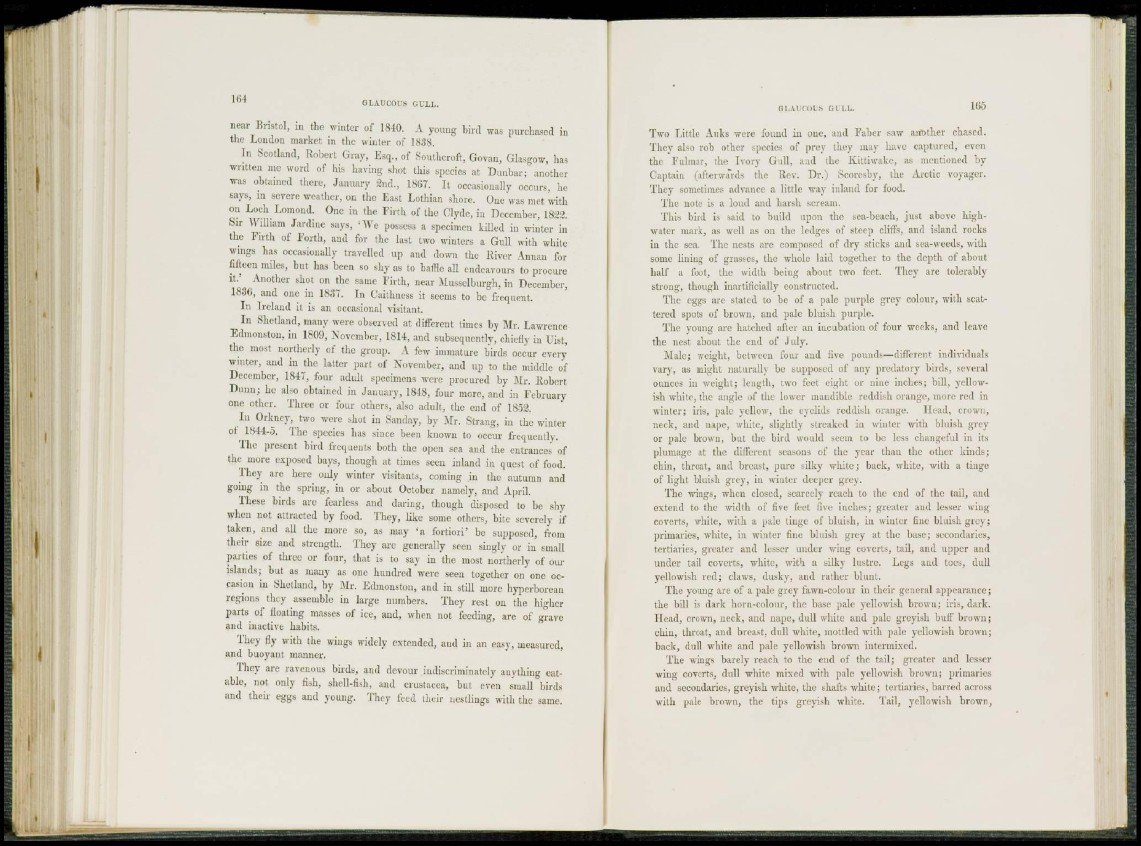
l d l
near Bristol, in the winter of 1840. A young bird was purchased in
the London markel in the winter of 1838.
I n Scotland, Robert Gray, Esq., of Southcroft, Govan, Glasgow, has
written me word of his having shot this species at Dunbar; another
was obtained there, January 2nd., 18G7. It occasionally occurs, he
says, in severe weather, on the East Lothian shore. One was met with
on Loch Lomond. One in the Firth of the Clyde, in December, 1822.
Sir William Jar d i ne says, ' W e possess a specimen killed in winter in
the Firth of Forth, and for the last two winters a Gull with white
wings has occasionally travelled up and down the River Annan for
fifteen miles, but has been so shy as to baflle all endeavours to procure
it.' Another shot on the same Firth, near Musselburgh, in December,
183t>, and one in 1837. In Caithness it seems to be frequent.
I n Ireland it is an occasional visitant.
I n Shetland, many were observed at different times by Mr. Lawrence
Edmonston, in 1809, November, 1814, and subsequently, chiefly in Uist,
the most northerly of the group. A few immature birds occur every
winter, and in the latter part of November, and up to the middle of
December, 1847, four adult specimens were procured by Mr. Robert
Dunn; he also obtained in January, 1848, four more, and in February
one other. Three or four others, also adult, the end of 1852,
I n Orkney, two were shot in Sanday, by Mr. Strang, in the winter
of 1844-0. The species has since been known to occur frequently.
The present bird frequents both the open sea and the entrances of
the more exposed bays, though at times seen inland in quest of food.
They are here only winter visitants, coming in the autumn and
going in the spring, in or about October namely, and April.
These birds arc fearless and daring, though disposed to be shy
when not attracted by food. They, like some others, bite severely if
taken, and all the more so, as may 'a fortiori' be supposed, from
their size and strength. They are generally seen singly or in small
parties of three or four, that is to say in the most northerly of our
islands; but as many as one hundred were seen together on one oc-
Ctision in Shetland, by Air. Edmonston, and in still more hyperborean
regions they assemble in large numbers. They rest on the higher
parts of floating masses of icu, and, when not feeding, are of grave
and inactive habits.
They fly with the wings widely extended, and in an easy, measured,
and buoyant manner.
They are ravenous birds, and devour indiscriminately anything catable,
not only fish, shell-fish, and Crustacea, but even small birds
and their eggs and young. They feed their nestlings with the same.
Two Little Auks were found in one, and Faber saw another chased.
They also rob other species of prey they may have captured, even
the Fulmar, the Ivory Gull, and the Kittiwakc, as mentioned by
Captain (afterwards the Rev. Dr.) Scorcsby, the Arctic voyager.
They sometimes advance a little way inland for food.
The note is a loud and harsh scream.
This bird is said to build upon the sea-beach, just above highwater
mark, as well as on the ledges of steep cliffs, and island rocks
in the sea. The nests arc composed of dry sticks and sea-weeds, with
some lining of grasses, the whole laid together to the depth of about
half a foot, the width being about two feet. They are tolerably
strong, though inartificially constructed.
The eggs are stated to be of a pale purple grey colour, with scattered
spots of brown, and pale bluish purple.
The young are hatched after an incubation of four weeks, and leave
the nest about the end of July.
Male; weight, between four and five pounds—different individuals
vary, as might naturally be supposed of any predatory birds, several
ounces in weight; length, two feet eight or nine inches; bill, yellowish
white, the angle of the lower mandible reddish orange, more red in
winter; iris, pale yellow, the eyelids reddish orange. Head, crown,
neck, and nape, white, slightly streaked in winter with bluish grey
or pale brown, but the bird would seem to be less changeful in its
plumage at the different seasons of the year than the other kinds;
chin, throat, and breast, pure silky white; back, white, with a tinge
of light bluish grey, in winter deeper grey.
The wings, when closed, scarcely reach to the end of the tail, and
extend to the width of five feet five inches; greater and lesser wing
coverts, white, with a pale tinge of bluish, in winter fine bluish grey;
primaries, white, in winter fine bluish grey at the base; secondaries,
tertiarics, greater and lesser under wing coverts, tail, and upper and
under tail coverts, white, with a silky lustre. Legs and toes, dull
yellowish red; claws, dusky, and rather blunt.
The young are of a pale grey fawn-colour in their general appearance;
the bill is dark horn-colour, the base pale yellowish brown; iris, dark.
Head, crown, neck, and nape, dull white and pale greyish buff brown;
chin, throat, and breast, dull white, mottled with pale yellowish brown;
back, dull white and pale yellowish brown intermixed.
The wings barely reach to the end of the tail; greater and lesser
wing coverts, dull white mixed with pale yellowish brown; primaries
and secondaries, greyish white, the shafts white; tertiarics, barred across
with pale brown, the tips greyish white. Tail, yellowish brown,